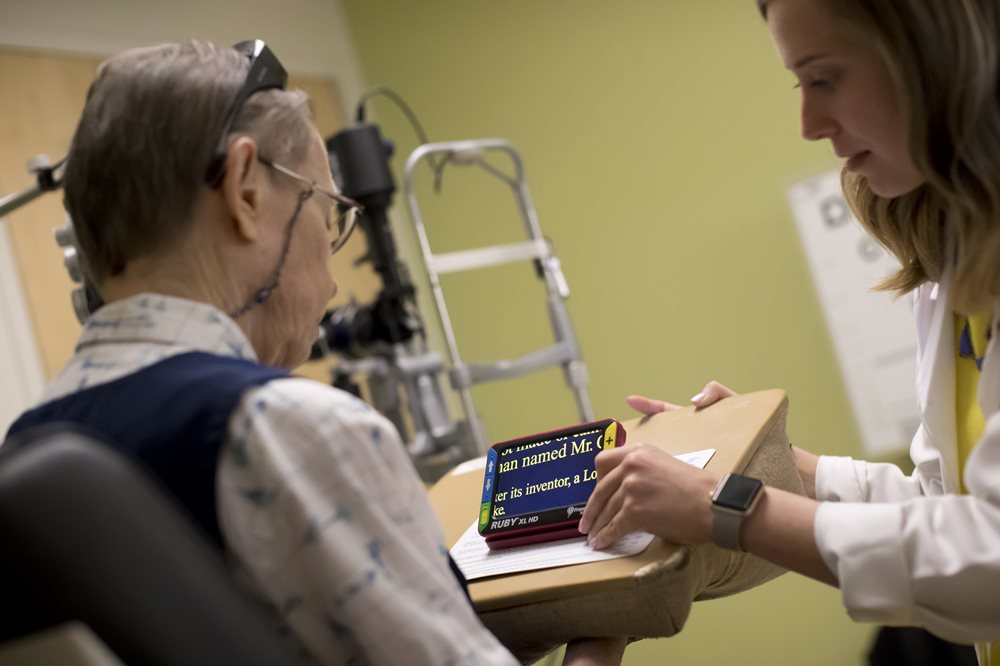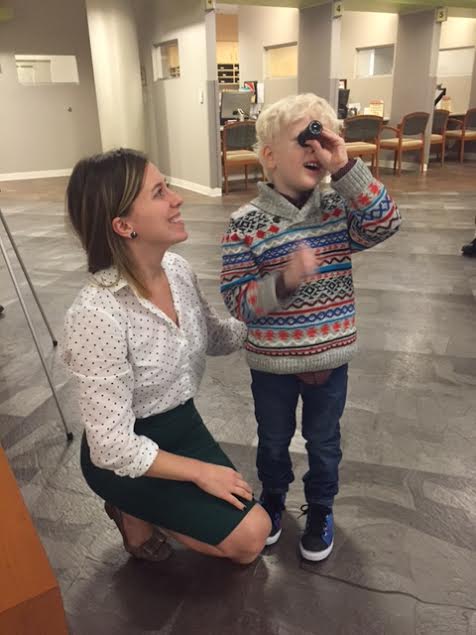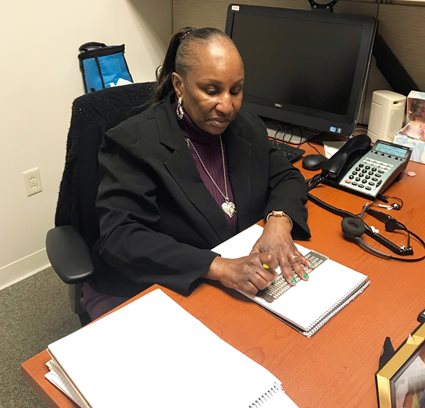Low Vision Services: A Discussion with Dr. Erin Kenny
February is Low Vision Awareness Month and we went behind the scenes with Erin Kenny, OD, FAAO, chief of the William Feinbloom Vision Rehabilitation Center, the low vision service housed at The Eye Institute (TEI).
 The Low Vision Center consists of low vision students, low vision doctors, a rehab staff that includes a certified low vision therapist, a certified orientation and mobility specialist, an occupational therapist, as well as social workers.
The Low Vision Center consists of low vision students, low vision doctors, a rehab staff that includes a certified low vision therapist, a certified orientation and mobility specialist, an occupational therapist, as well as social workers.
The day starts, according to Dr. Kenny, with a review of the different pathologies the patient may have and issues they may be experiencing with accomplishing their goals. “We talk about psychosocial aspects a patient may be experiencing. We also brainstorm ideas about how to help the patient. I do have to say, I should probably put this out there first, that we are a low vision service. We work with patients who are visually impaired. They come in, it's a very goal-oriented exam. These patients have a visual impairment from several different types of pathologies and we help them accomplish their goals”, said Dr. Kenny.
The patient’s goals may be reading the Bible, or seeing the television a little bit better. It could be seeing the pins down at the end of the bowling alley a little bit clearer, or maybe feeling a little bit more comfortable navigating in their environment. One patient may be set on seeing the computer a little bit better, and the next patient wants to be able to see their grandkids' faces. Even if it's the same pathology, same age, same demographic, a patient’s goals could be completely different.
“We see a lot of patients with different pathologies and the (optometric) intern will get to work with the patient, said Kenny. “Then they come back to the doctor and we get to discuss and brainstorm different ways that we can help a patient that may be with devices, it could be with non-optical options, or it could be with the appropriate referrals.”
 Dr. Kenny stressed the importance of having an interdisciplinary team. At the Feinbloom Center rehab specialists and social workers are housed in the clinic, enabling the optometrists to consult on-site.
Dr. Kenny stressed the importance of having an interdisciplinary team. At the Feinbloom Center rehab specialists and social workers are housed in the clinic, enabling the optometrists to consult on-site.
“Other practices may have to refer out and some practices don't have a social worker. Having the ability to interact with interdisciplinary professionals, it's really special because everything is already under one roof. We're able to work together. That’s one thing I would want people to know. It's not your regular eye exam because there's other specialists and other professionals there to help you,” said Kenny.
Within the last year, the Feinbloom Center began doing free genetic screenings, which provides helpful information to the patient and the clinician. Low vision patients may include those with inherited retinal dystrophies or other inherited ocular pathology. Genetic testing results helps with the management of the disease as well as the discussion with the patient on what can be done to assist them.
“There's this moment sometimes, and I love to experience it with the intern as well, when you show a device to a patient and they're able to read that print that they have not been able to read in years - that moment of pure joy of being able to do something that they haven't been able to do in a very long time.”

Dr. Kenny spoke of a recent patient, who was able to view a photo of his nephews on Facebook, with the help of a video magnifier. It had been the first time in two years that he was able to see their faces.
“Those are the moments that make working at TEI and working at the William Feinbloom Vision Rehabilitation Center so special - helping patients achieve their goals. Sometimes it's heartbreaking because patients will ask - why did it take so long for someone to refer me to you? Or, why didn't I know that you guys existed?” said Dr. Kenny. “That's probably the heartbreak of my job, that sometimes these patients have not been getting the help that they need or they don't realize that low vision services exist. But the reward of being able to help those patients makes it all worth it.”
“I want people to know that there is no cutoff for visual acuity to be seen in the low vision service. Sometimes people will say they're 20/25. That's only one line worse than 20/20. They don't need to go to low vision. But whether it's you, a family member, a friend or just someone that you know that is unable to do something because of their vision, it's worth a call to the Feinbloom Center to see if there's something we can do to help,” Kenny said. “People have this misconception that low vision is all about just devices, where it's handheld magnifiers or telescopes, but low vision is so much more.”
According to Dr. Kenny, everybody's actually walking around with a low vision device in their pocket. Cell phones could be utilized as a low vision aid by changing accessibility options or downloading various apps.
“We do not take into consideration visual acuity or visual field when it comes to seeing a patient or being referred for low vision, it's all about their functional vision. It's worth a call to the Feinbloom Center to see if we can help them. It's not being legally blind or it's not having vision worse than 20/70. You can be having functional issues with 20/25 acuity and our service exists for people like that, as well,” stressed Dr. Kenny.
 “We have a social worker who works at the Feinbloom Center, Virginia Scott who is completely blind. She has no light perception in both eyes,” she said. She utilizes her iPhone every day and has it set up so she can communicate – she texts, emails and there is no visual cutoff to being able to use a cell phone. “Probably one of the first questions I ask my patients is, "Do you have a smartphone?" Because there's a lot of things that we can do on that,” Dr. Kenny said.
“We have a social worker who works at the Feinbloom Center, Virginia Scott who is completely blind. She has no light perception in both eyes,” she said. She utilizes her iPhone every day and has it set up so she can communicate – she texts, emails and there is no visual cutoff to being able to use a cell phone. “Probably one of the first questions I ask my patients is, "Do you have a smartphone?" Because there's a lot of things that we can do on that,” Dr. Kenny said.
The Feinbloom Center provides various services to assist patients with visual impairments including:
- Comprehensive low vision evaluations for adults and children
- Prescription and dispensing of low vision devices and adaptive equipment
- Rehabilitative training in the use of remaining vision
- Adaptive technology evaluations
- Referrals to agencies that offer assistance in obtaining adaptive equipment and rehabilitative services
If you or someone you know lives with low vision and is in need of vision rehabilitation services, please contact TEI at 215.276.6111 to make an appointment.